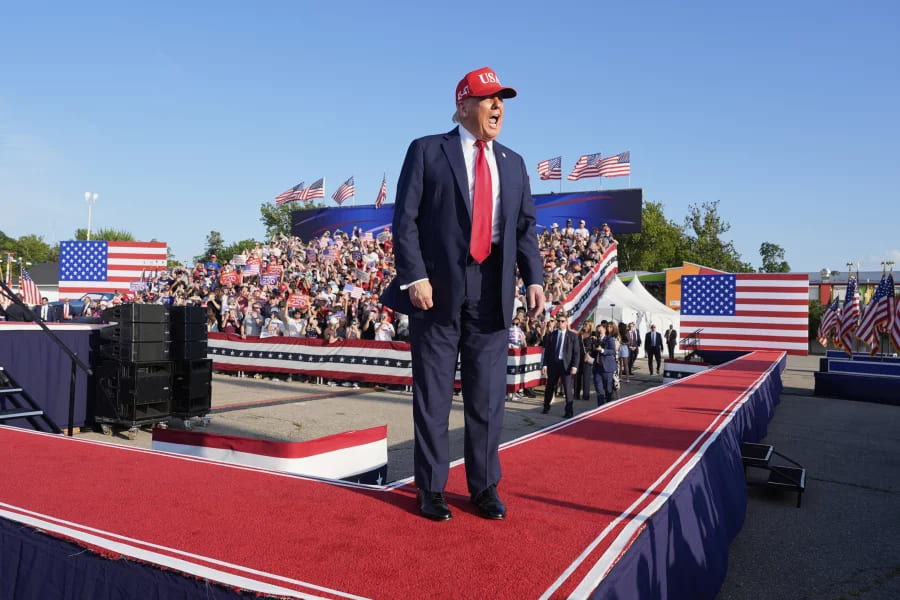President Donald J. Trump has threatened to impose a 30% tariff on all goods imported from Mexico and the European Union starting August 1, 2025, unless both trading partners agree to renegotiate existing trade terms. The move marks a sharp escalation in Trump’s aggressive trade policy as he begins his second term in office.
The theatrics-laden bombshell arrived in the guise of open letters posted on Trump’s Truth Social platform late Friday, evoking worries of a fresh global trade war at a moment shortly before the U.S. presidential election.
Trump’s Justification: “Unfair Trade Practices”
In his letter to European Commission President Ursula von der Leyen, Trump attributed the fault to the EU for decades of trade policies that have long harmed American industries and workers. Trump asserted that America has suffered a “chronic imbalance” and it was time to “restore fairness.”
The EU has become very rich on the backs of American taxpayers,” Trump said. “This 30% tariff will stick unless there is swift movement on a two-way trade agreement.”
Also, in another letter to Mexican President Claudia Sheinbaum, Trump recognized Mexico’s efforts to stem illegal immigration and prevent the trafficking of fentanyl. Yet he underlined that these were “not enough to warrant the continued one-sided trade relationship.
He added further, “America cannot be Mexico’s economic crutch while drugs and migrants cross our borders unchecked.”
EU and Mexico Respond Quickly
Brussels and Mexico City were quick to react. Mexican officials showed “serious concern” and stressed their commitment to not engaging in confrontation, pointing out that senior trade officials had been sent to Washington for urgent consultation.
President Sheinbaum called the threat of tariffs “a setback to regional cooperation” and warned of retaliation if the negotiations failed.

The EU officials, on their part, condemned the threatened tariffs as “unjustified economic aggression.” Ursula von der Leyen said, “We will always prefer dialogue, but Europe will not hesitate to defend its industries and workers if these tariffs are imposed.”
European diplomats are currently drawing up contingency plans, including retaliatory tariffs on quintessentially American products such as motorcycles, bourbon, and blue jeans raising the specter of 2018 trade war measures.
Markets Watch Closely, Businesses Cautious
Despite the geopolitical surprises, global financial markets have been quiet until today. The Dow Jones Industrial Average fell slightly, but analysts believe investors are still holding onto the possibility that Trump might reverse his direction or postpone implementation.
This anticipation has given rise to what some traders jokingly refer to as the “TACO” theory short for “Trump Always Chickens Out.” It encapsulates Trump’s pattern of making bombastic threats only to then shift direction or retreat, oftentimes using such statements as a negotiating ploy.
But supply chain experts warn that even threats of such brutal tariffs can disrupt planning for manufacturers, particularly in sectors like autos, electronics, pharmaceuticals, and agricultural products.
A senior executive at a major U.S. automaker, speaking on condition of anonymity, said, “If tariffs are imposed, it will double the production cost. Some may even consider shifting supply chains overseas.”
This is the most recent in a trend from Trump’s campaign and policy efforts in 2025. He has imposed or threatened to impose new tariffs through April on Canada, Japan, South Korea, and several others. Rates in most cases have been 15% to 35%. Brazil has had one of the most stringent tariffs so far at a 50% tariff on its steel and electronic exports.
Trade experts say such moves are all part of Trump’s broader effort to restore American manufacturing dominance and reduce dependence on international imports. Opponents, however, retort that this policy risks being self-defeating, damaging U.S. export markets, and placing inflationary pressure on America.
“There is a thin line between protectionism and economic patriotism,” Georgetown University trade economist Dr. Alicia Simmons said. “A 30% across-the-board tariff on two of our most reliable trade partners risks jeopardizing diplomatic relationships as well as supply chain security.”
The action is taken at a sensitive point in the American political calendar. With the 2024 presidential election just months away, Trump is doubling down on his nationalist, “America First” message a strategy which propelled him to the presidency in 2016.
Pollsters indicate that the threat of tariffs could galvanize votes from Rust Belt voters and factory employees who have been left behind by globalization. However, it may lose support among moderates and business circles that favor open trade.
President Joe Biden, who is currently seeking re-election, has not yet responded in a direct statement to the new tariff statement. White House press secretary Karine Jean-Pierre did say, however, “The administration is dedicated to fair trade and constructive relationships. Blanket tariffs are not about those values.”
August 1: Deadline or Bluff?
With the clock ticking against the self-imposed August 1 deadline, the world is now in a waiting game. Brussels and Mexico City negotiators, according to reports, are looking at options to avoid a tariff crisis, including short-term trade concessions or another type of framework agreement.
Meanwhile, Trump continues to position things as a matter of resolve: “Either they complete the deal, or we do it for them. No more terrible deals for America,” he tweeted on Saturday.
Whether this is strategic maneuvering or a genuine trade war in the making remains to be determined. One thing is sure, however, and that is the world is again bracing itself for the uncertainty and chaos that seem to follow Trump’s high-stakes economic diplomacy.
Related News
Trump Threatens Sweeping 35% Tariffs on Canadian Imports Amid Renewed Trade Tensions
Federal Agents Clash with Protesters During Raid on Camarillo-Area Cannabis Garden
Tragedy in Texas: Over 100 Lives Lost in Devastating Flash Flood
